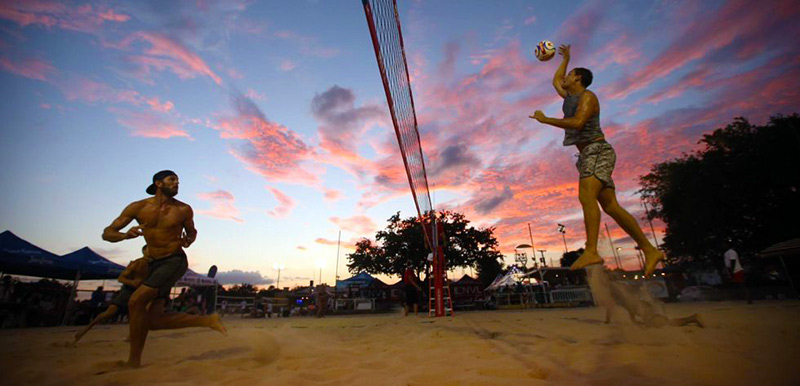
One of the most exciting aspects of beach volleyball is the volleyball spike. While it may look easy and effortless when watching the pros, realize that hitting is tough to learn and master. To master the art of the volleyball spike, you are required to have excellent agility, quickness, power, and coordination. While spiking in indoor volleyball isn’t easy, spiking in the sand can make the whole process much more challenging. Spiking in the sand is certainly not an easy task, but once you get the hang of it, it will certainly add another level to your game.
For those of you who are new to beach volleyball or maybe you’re transitioning from indoor to beach, realize that the techniques for spiking are somewhat different than spiking indoors. So if you are a new player, a transitioning player, or are just looking to refine your game, check out these helpful beach volleyball spike tips.
• Once you pass the ball, move quickly towards the net. Make sure your strides are long, not short and choppy and try to take as few steps as possible. Make sure that your last stride is a long and powerful one.
• While you can broad jump or drift while jumping when playing indoor, in beach volleyball, it is advised that you jump straight up. By jumping straight up, you will be less likely to get stuck.
• After your last stride, bring your trailing leg forward in order to close the approach and plant both feet before you jump. Make sure you are swinging your arms back as you plant your feet, and bring your arms forward as you lift from the ground.
• Beach volleyball requires a different amount of steps than indoor to get into position for the spike, as it’s not so ‘rigid.’ Realize that in beach volleyball you can take as many steps as you need to get into position, so there is no need to count your steps.
• You want to align yourself into the optimal hitting position. So if you are a righty, use your right leg for the stride and use your left to close as you plant to jump. If you are a lefty, reverse this.
• When you jump up, make sure your knees are bent, and you are exploding upwards as hard as you can. As you throw your hands upward, be sure to keep your eyes on the ball!
• If you are playing on the left side of the court and you are a righty (or vice versa), start off your approach by facing the direction that gives you the greatest angle. Doing this allows you to hit the angle straight on, but still giving you the option to hit the ball down the line.
• If you are playing on the right side of the court and you are a righty (or vice versa), start off by approaching the net facing down the line. This will allow you to hit the ball straight or at an angle.
• As you jump straight up out of the sand, make sure the ball remains in front of your body. Ideally, you want to make contact with the ball roughly 6 inches from your body.
• Before you swing at the volleyball, draw back your hitting arm. Make sure it is behind your head, and as you swing forward, extend your arm upward. You want to make contact with the ball as high as you can.
• By making contact with the top of the ball with your palm, you can put a top spin on the ball. By doing this, you will drive the ball down the court and are less likely to hit the ball out of bounds.
• When setting up for the spike, always make it look like you are aiming to wallop the ball. By doing this, you disguise your shot and gives you the option to trick the opponent by allowing yourself the choice to swing hard or shoot a soft shot.







